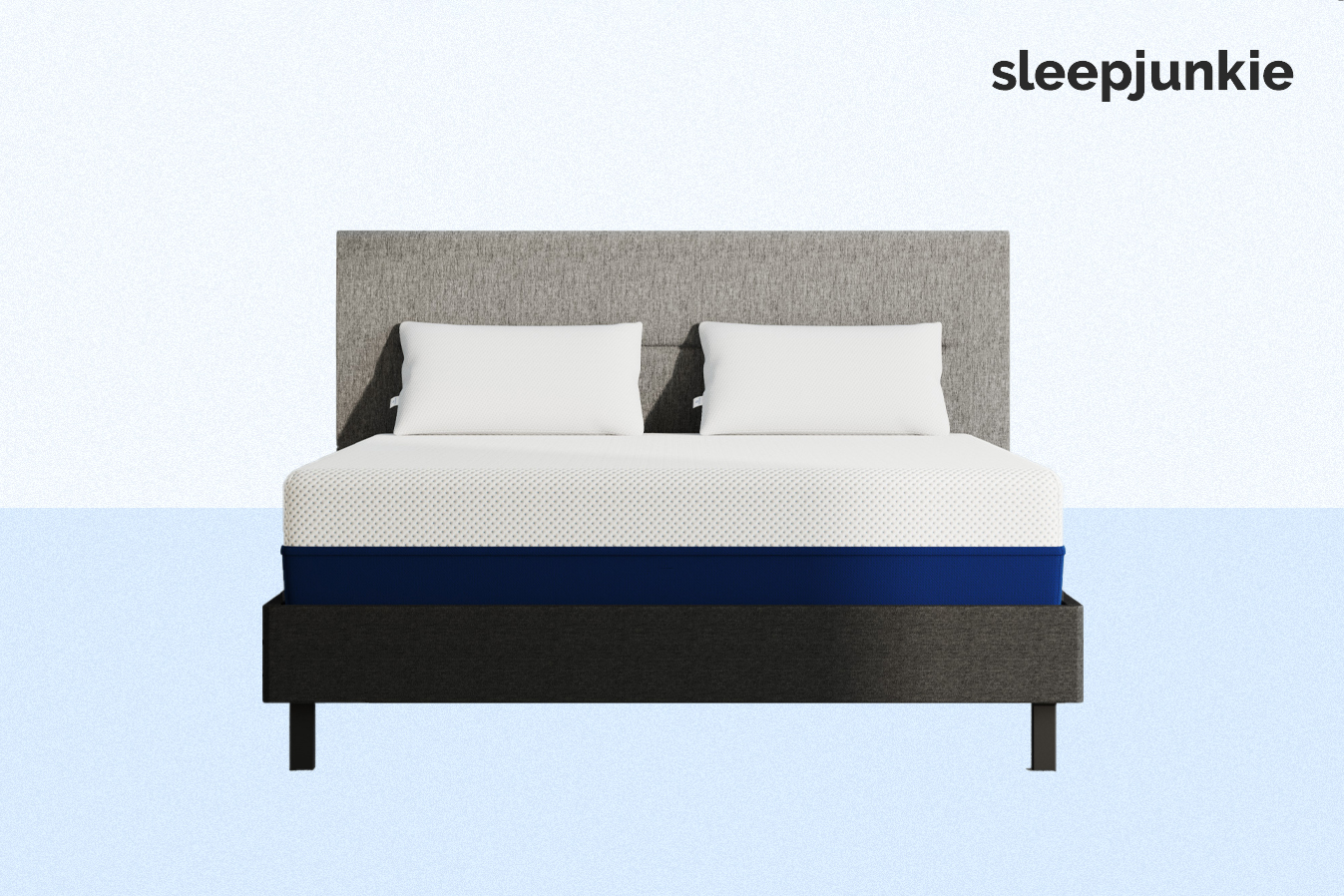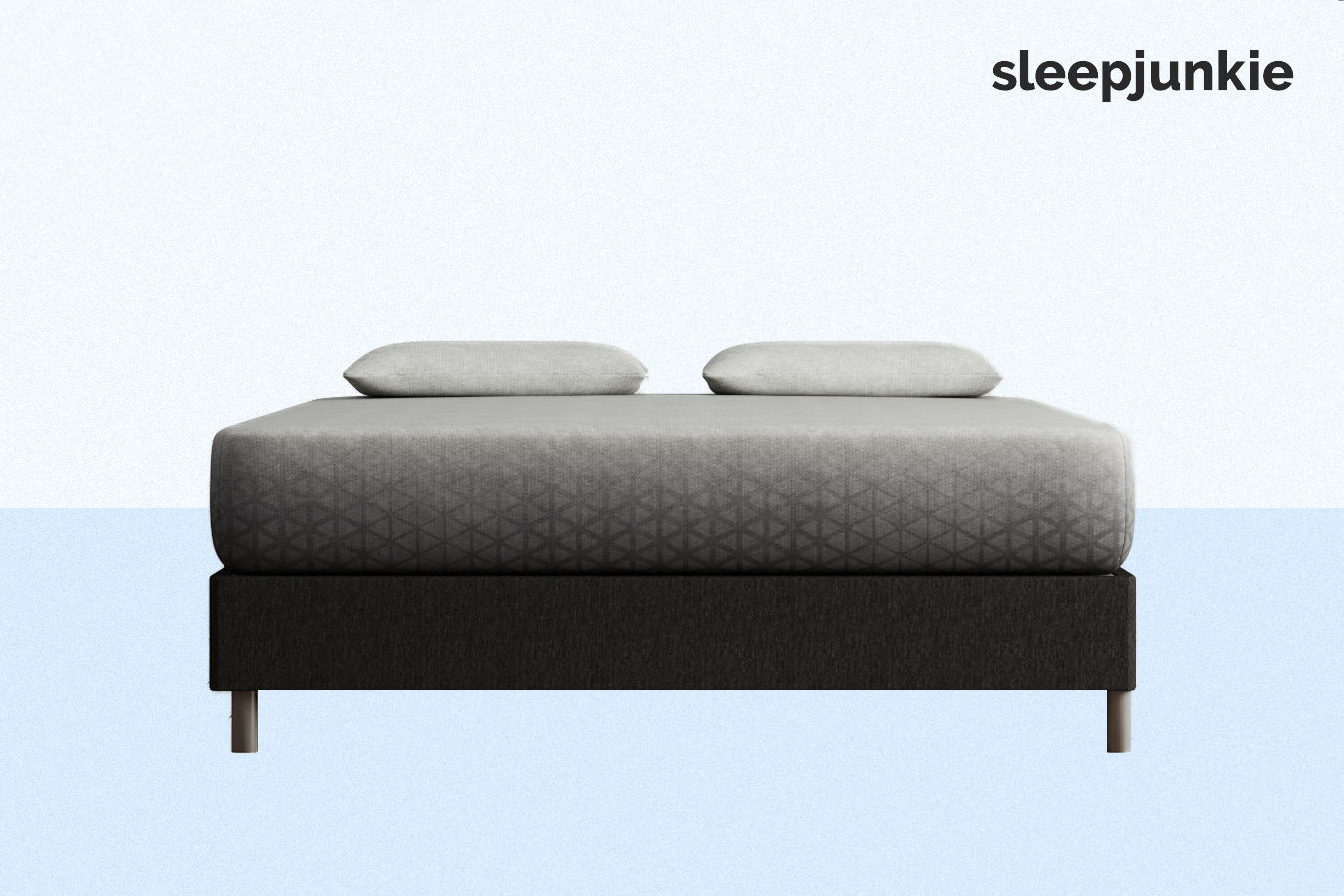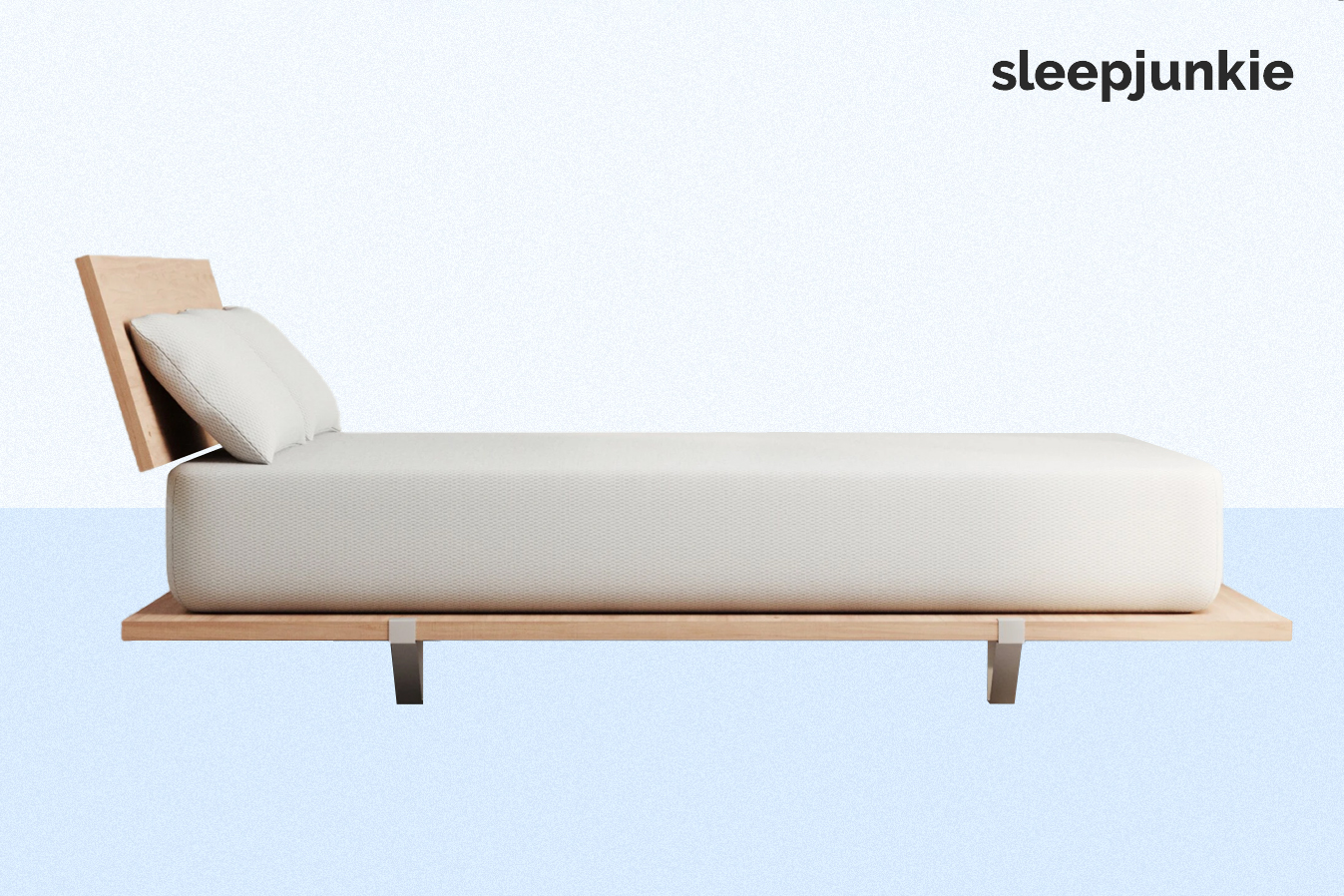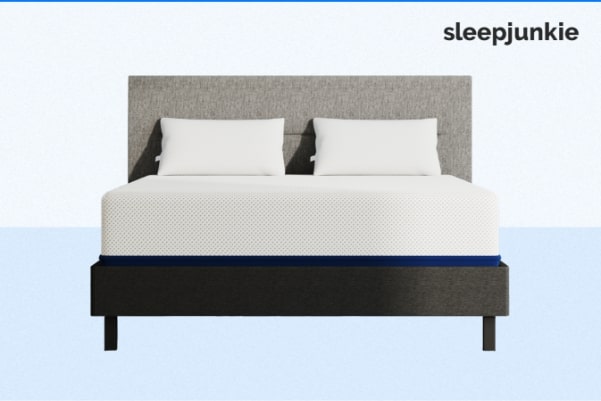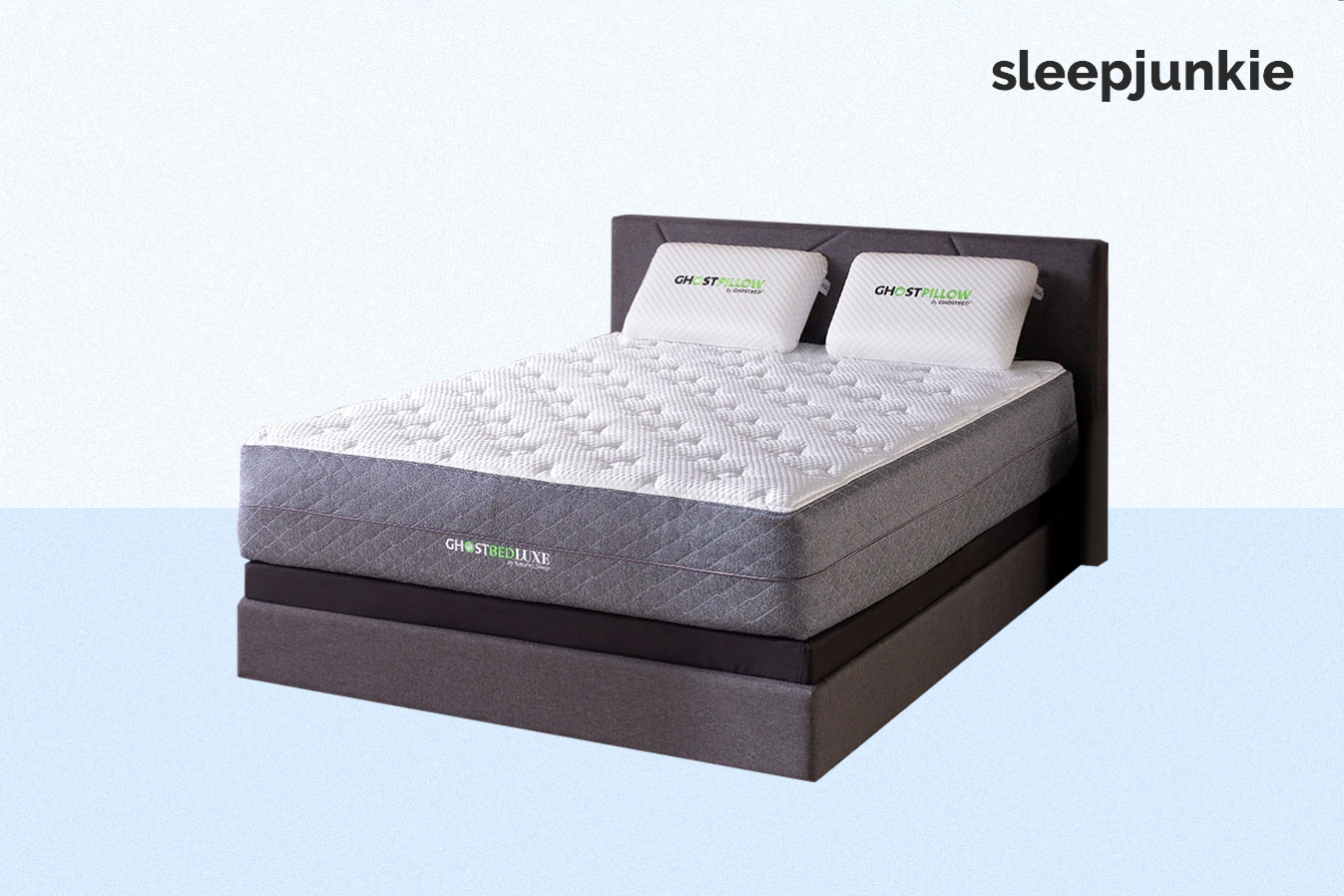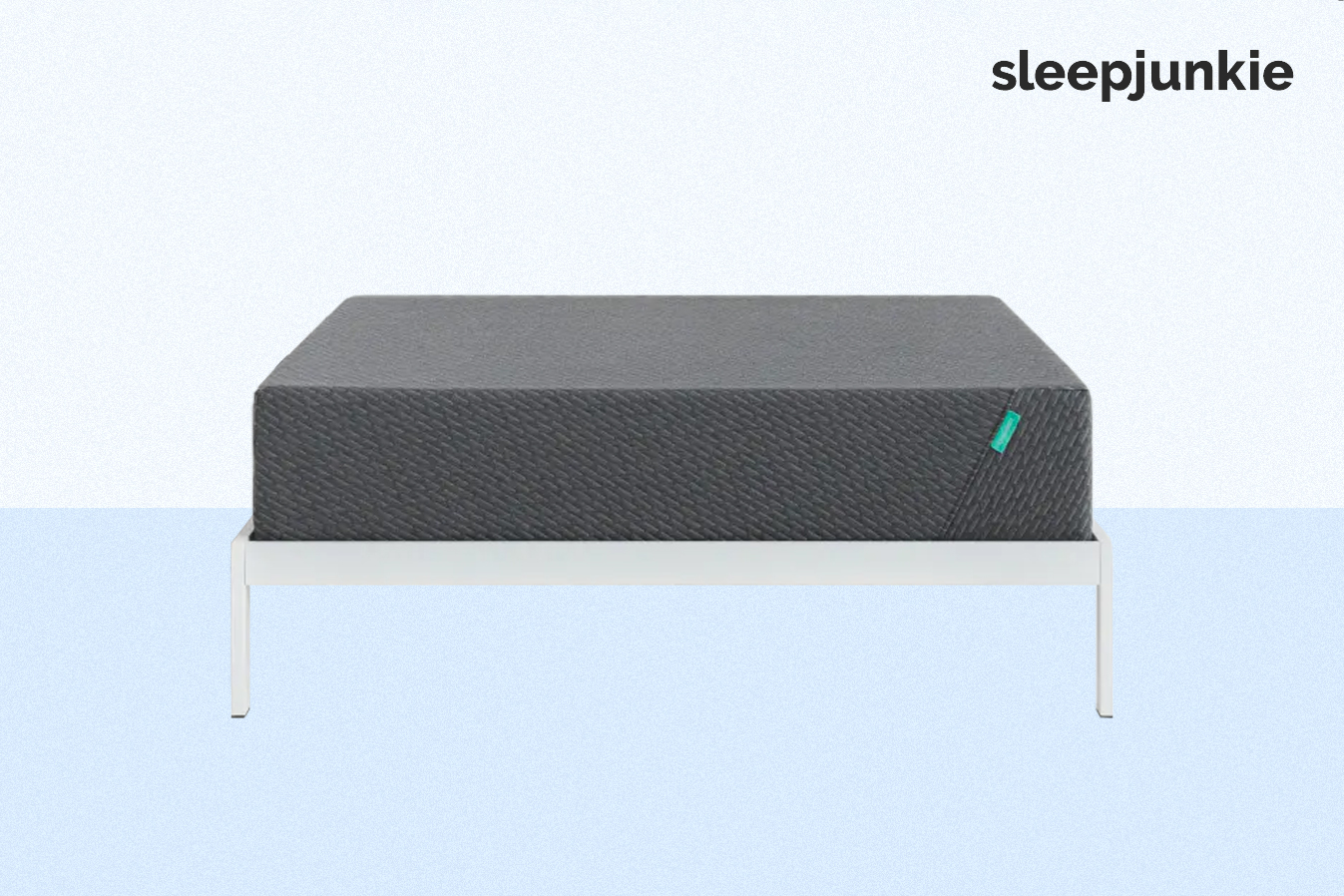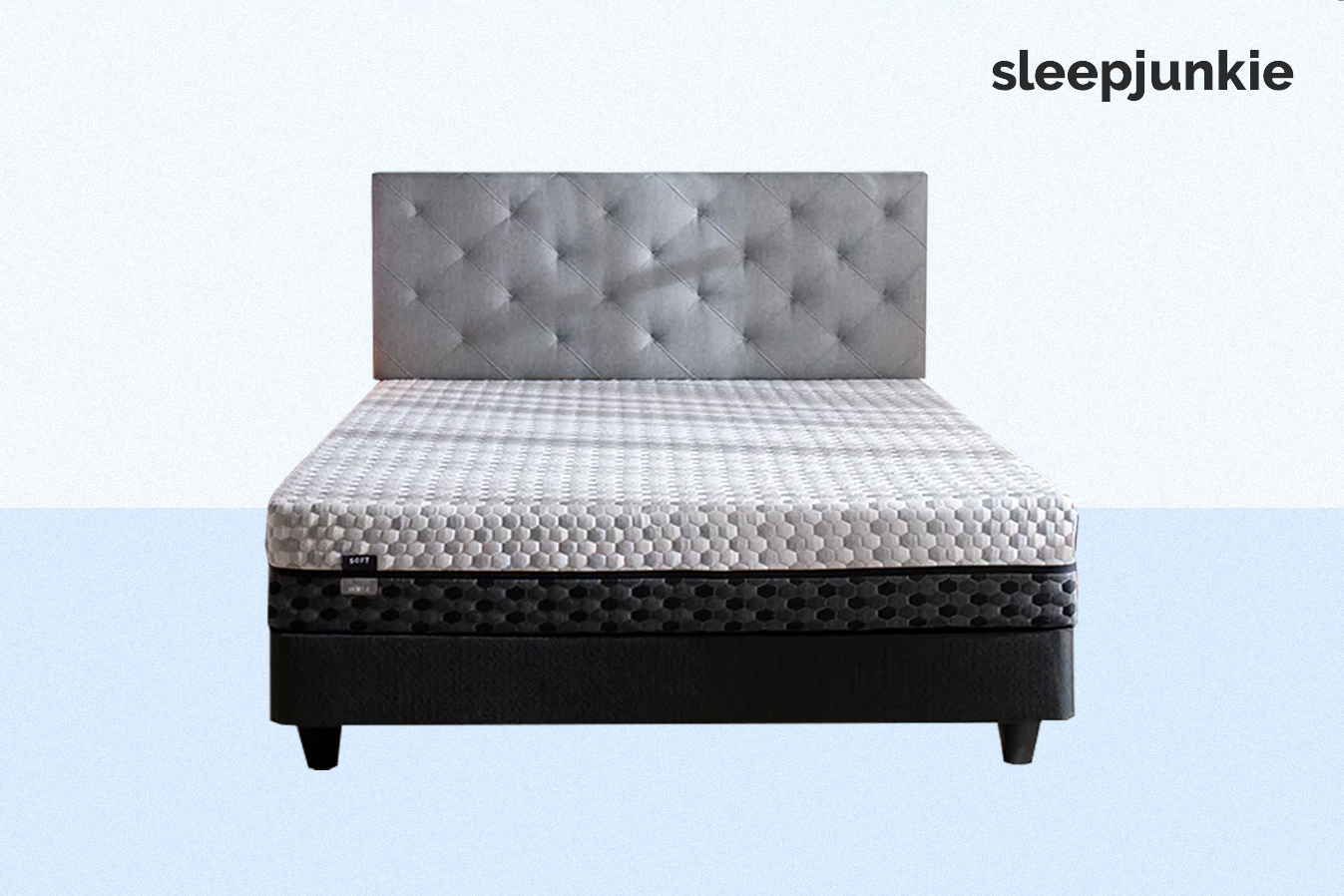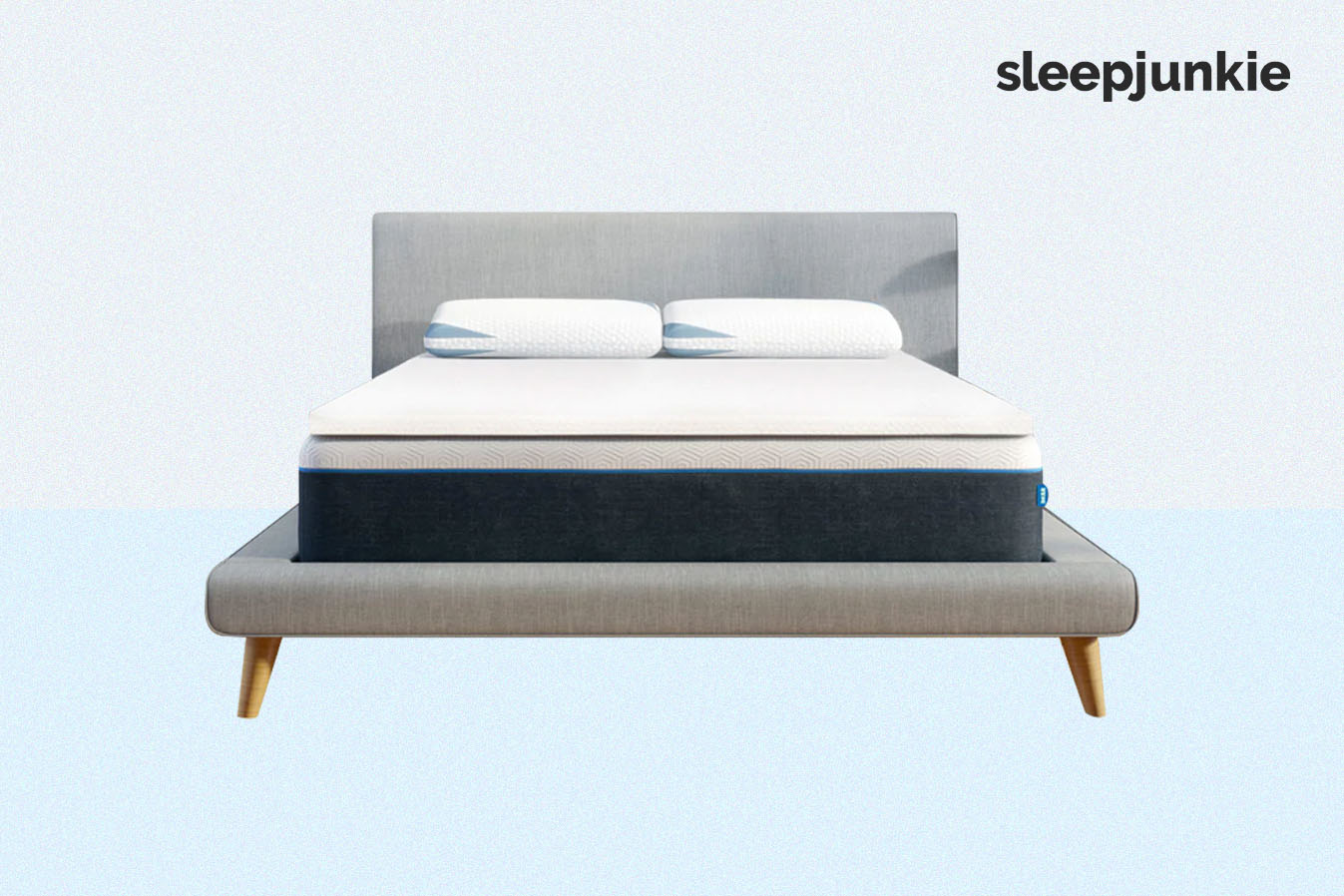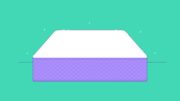Best Memory Foam Mattress of 2024: Reviews and Buyer’s Guide

In 1966, NASA developed memory foam to use as cushioning in their rocketships. Specifically, it was engineered to relieve stress astronauts were subjected to during takeoff. Now, memory foam is found in hundreds of mattresses on the market today. There are many benefits to sleeping on memory foam, they contour to your body, ease aches and pains, and aid in healthy rest.
In this guide, we’ll discuss the pros and cons of these beds as well as our top-rated recommendations to help you find the best memory foam mattress for yourself.
Amerisleep AS3 Overview
Amerisleep’s AS3 mattress is the best memory foam mattress because it is engineered to deliver an even balance of comfort and support, and is versatile enough to adapt to a variety of sleepers. The AS3 is the middle-of-the-road option when it comes to firmness, with Amerisleep offering four other numbered models, two softer and two firmer than the AS3.
A queen AS3 comes in at $1,499 in price, but Amerisleep regularly runs mattress promotions, so if you watch their site, you could probably snag a deal.
Amerisleep offers a 100-night trial free shipping and a 20-year warranty with each of their beds.
- Medium Feel for Back Support
Gently firm feels are usually best to prevent spine misalignment.
- Sustainably produced, breathable memory foam
While most memory foams are wholly synthetic, Amerisleep uses plant oils in theirs, along with more traditional ingredients.
- Targeted support from middle foam layer
The surface feels softer and firmer under the body as needed.
When you lay on this layer, the memory foam will hug your body’s curves and offer instant comfort. However, this layer is also designed to be responsive, ensuring you don’t feel trapped in the bed. Bio-Pur® foam provides the perfect balance between softness and support, which is part of the AS3 is recommended for most sleep styles.
- JR: We’ve had this mattress for 3 years now and it’s the best mattress we have ever bought. It’s held its shape, does not make you hot like others do and I no longer toss and turn because of being uncomfortable.
- Ari: It’s changed our lives. Sleeping better, feeling better, we are a happier couple because of this bed.
- Jdmilly: I have herniated discs and back problems. I’ve also had four knee surgeries. Despite the setbacks I stay physically active. I’ve had the cal-king for almost two years now. It’s the best bed I’ve ever had!
Comfort Layers
The top layer of the AS3 is Amerisleep’s Bio-Pur® foam. This plant-based memory foam is five times more breathable and than traditional memory foam, allowing for air to easily pass through this layer.
Transition Layers
Amerisleep uses HIVE® technology in its next layer to offer unbeatable zoned support. To make this technology, they cut hexagons in strategic comfort zones. In areas where you need more support, these hexagons are placed closer together and feel firmer to prevent you from sinking unhealthily far into the mattress. This responsive support means you’re unlikely to wake up with stiff shoulders or a sore back.
Support Layers
The last layer of this mattress is Amerisleep’s Bio-Core® foam. The base of the mattress is durable foam designed to help prolong the lifespan of the mattress by preventing premature deterioration and sagging. Amerisleep also backs their beds with an impressive 20-year warranty.
Zoma Hybrid Overview
Next up on our list is the Zoma Mattress, a memory foam mattress for athletes. The goal behind the Zoma was to create a mattress that can help athletes get deeper, better sleep in order to recover faster and play harder. If you live an active lifestyle, the Zoma is for you.
The Zoma Mattress comes with a 100-night sleep trial and a 10-year warranty.
- Gel Foam
Gel foam molds to the body for relief
- Comfortable Transition Layer
Buoyant transition layer mimics latex
- Built to LastDurable base form extends mattress longevity
The memory foam feels soft without being overbearingly plush, thanks to the underlying foams that add responsive support. People who lie on their sides and backs should find the Zoma Mattress a comfortable choice that keeps them from waking early during the night.
- Lisa H: I’ve had my zoma for 6 months and it’s the best mattress I’ve ever had.
- David S: This hybrid foam with coils has proved to be a perfect combination of foam and coils. I’ve not woken up with back pain in the three weeks that I’ve slept on it!
- Stephen F: It’s perfectly supportive of me as a side sleeper, I would highly recommend this mattress!
Comfort Layers
The first layer of the Zoma is 2 inches of cooling memory foam mattress. When you lay on this bed, the memory foam molds to your body to offer instant cushioning comfort. The gel within this layer combats body heat to keep you sleeping comfortably.
Zoma’s Triangulex™ technology is located within the top layer of their bed to offer your back dynamic support. Around your shoulders and legs, this technology contains triangle-shaped cutouts to allow for deeper compression and pressure relief— this is especially important for side sleepers who need extra cushion near those major joints. Then, this technology firms up the midsection of the top layer, allowing for extra lumbar support and preventing uncomfortable sinkage.
Transition Layers
Next, is a layer of highly-responsive Reactiv™ foam— a latex-like poly-foam. The responsiveness of this layer gives the bed a bit of bounce and creates a more “on top of the bed” feel in regards to firmness. Primarily, Reactiv™ functions as a transition foam between the cushioning memory foam above and the durable core of the mattress below.
Support Layers
Last but not least is the core of the mattress, durable Support+ foam. The Support+ foam reinforces the two layers above and prevents premature deterioration and sagging.
Vaya Mattress Overview
Are you shopping for a new foam mattress on a tight budget? You don’t have to compromise and settle for a less-than-stellar mattress. The makers of the Vaya Mattress created a bed that’s affordable yet offers the pure comfort and support of a luxury memory foam mattress.
Every Vaya Mattress includes a 100-night sleep trial, and if you’re not satisfied after thoroughly trying it out you can return it for a full refund. The Vaya Mattress is also backed by a 10-year limited warranty.
- Budget-Friendly, High-Quality Construction
Affordable design focused on pure comfort
- Comfort Materials
Top layer relieves pressure in any position
- Durable Base
Base layer resists sagging and impression
Vaya has a 4.1-star rating on Amazon, with plenty of customers praising the mattress’s feel. A complaint that’s come up more than once is the mattress’s lack of edge support, with a couple of owners complaining the soft edges could make it difficult to get out of bed. However, some like it over a firmer mattress.
- Natalie E: This Vaya mattress is amazing! It’s supportive and comfortable, just like a hug for your body.
- Joan C: It was time to replace my son’s mattress so I ordered a Twin XL for him. He is very happy with his new mattress and slept well from the first night. It has now been two weeks and he is still sleeping well.
- Mary B: Excellent. Soft top, firm under that. Regular foam as opposed to memory foam doesn’t let me sink all the way down to firm layer.
Comfort Layers
A Vaya Mattress has two layers wrapped in a soft and breathable cover. The bed’s basic construction still provides the mix of responsive support and pressure-relieving cushion that sleepers need for a good night’s rest.
Support Layers
The top layer is 3 inches of Vaya Comfort Foam, an airy and adaptable material that molds to you for pressure relief. Underneath the Vaya Comfort Foam is 9 inches of Vaya Base Foam, a sturdy material that promotes mattress longevity. Buyer Mary B says, “Soft top, firm under that. Regular foam as opposed to memory foam doesn’t let me sink all the way down to firm layer”.
Amerisleep AS5 Overview
The softest mattress Amerisleep offers is their AS5. Despite being so soft, their AS5 is actually a great mattress for heavy sleepers. While sleepers over 250 pounds often struggle to find a soft but supportive mattress, the AS5 is designed to be just that. In fact, “good support” is the second most recurring phrase in customer reviews, topped only by the word “comfortable.” Customers seem to can’t get enough of this comfortable memory foam mattress. One happy customer describes his experience as, “We have three Amerisleep matresses in our primary home and loved them so much that we decided to buy two more for our winter home”. User Kay adds to her it is better than a traditional memory foam mattress. “This mattress surpassed my expectations”, she said in her review.
The AS5 features a lightweight, removable cover and comes with a 100-night sleep trial and a 20-year warranty just like the other Amerisleep mattresses.
- Thick Cushion
Thick cushion of plant-based memory foam.
- Soft Yet Bouncy
Active Flex supplements the soft feel with some bounce
- Targeted Support
Targeted support from Affinity foam layer’s cutouts.
The ultra-soft AS5 combines pressure-relieving memory foam with supportive Active Flex to offer side sleepers, combo sleepers, and heavy sleepers a comfortable night’s sleep.
- Happy Customer: We have three Amerisleep matresses in our primary home and loved them so much that we decided to buy two more for our winter home.
- Kay: This mattress surpassed my expectations. I was very hesitant to order a mattress offline. I’m usually the person hopping from store to store to lay down and try it out. I’ve been getting the best sleep I’ve gotten in YEARS.
- Reem: This mattress was great! I tried soo many mattresses including a tempur pedic, purple and none of them had the pressure point relief that this mattress has. Definitely a keeper.
Comfort Layers
The first layer of this mattress is an ultra-soft and cooling breathable layer to sleep better and avoid overheating.
Transition Layers
The AS5 contains an extra layer none of the other Amerisleep mattresses have– Active Flex. Active Flex is a latex-like poly-foam, and the inclusion of the Active Flex layer prevents plus-size sleepers from sinking uncomfortably far into the mattress. Many customers have noted in their reviews that it’s simple to switch sides on the AS5, saying that the mattress was ultra-soft yet buoyant.
Support Layers
All in all, the AS5 has four layers: 3 inches of Bio-Pur®, 2 inches of Active Flex, 2 inches of Affinity with HIVE®, and 7 inches of Bio-Core®.
GhostBed Luxe Overview
Traditional memory foam models hasve a reputation for sleeping hot, but variations like the GhostBed Luxe are designed to provide sleepers with the ultimate in cooling experiences. The GhostBed Luxe features multiple layers to form the company’s two-stage cooling design. Some customers like Katherine S. say it helps with joint pain. “But no joke, I’m sleeping so much better than I ever have! I’m not tossing and turning through the night. I’m not waking up with my back hurting anymore”, she wrote.
The GhostBed Luxe is backed by 101-night sleep trial and a 25-year warranty.
- Made in the USA
Constructed in the United States for quick shipping.
- Several Cooling Layers
Multiple cooling layers inside a breathable cover fabric.
- Blended Layers for Comfort
Bouncy transition layer and a dense support core.
The GhostBed Luxe is designed to offer a softer feel than the original GhostBed, featuring a medium feel suitable for most sleep styles. GhostBed labels the mattress as their “best cooling” model. Other models GhostBed offers includes two hybrid models and a latex mattress with wool and organic cotton.
Customers reviews are overall approving of the GhostBed Luxe, with the majority of people rating the mattress as five stars. Many people credited the Luxe mattress as the reason their sleep had improved, with less tossing and turning reported by some.
- Katherine S: I was skeptical at first about the claims of this bed. But no joke, I’m sleeping so much better than I ever have! I’m not tossing and turning through the night. I’m not waking up with my back hurting anymore.
- Jennifer P: The other reviewers are right. This bed is great! Not too firm or too soft, just right. Customer service is top tier.
- Linda T: Very supporting and comfortable. Highly recommend this mattress.
Comfort Layers
The mattress cover is Ghost Ice Fabric, a proprietary material designed to feel cool, soft, and supple to the touch. An inch of immediate cool burst airflow technology fiber is woven into the mattress’s cover.
Next is a layer of gel foam that’s an inch thick. The gel foam hugs the body within seconds of lying down.
Underneath the gel foam is the special Ghost Ice layer, which relies on thermo-sensitive technology to react to heat and promote a cooler feel. A layer of Ghost Memory Foam rests underneath the Ghost Ice Layer, deepening compression for pain relief and spine support.
Support Layers
The support layers are the Ghost Bounce Layer and the core of high-density foam. The Ghost Bounce foam is engineered to conform like memory foam but respond to movements like latex, offering the best of both. The company describes it as ” close as you can come to floating without leaving the ground.” Some reviewers agree it is better than any all foam bed. “The mattress does not transfer movement which is awesome so you won’t disturb your partner! The bed is foam layered which offers a lot of support, especially for side sleepers like myself”, says purchaser Kim M.
Tuft & Needle Mint Overview
Tuft & Needle makes mattresses using their exclusive material, T&N Adaptive® foam. Their Tuft & Needle Mint Mattress is an affordable yet luxurious option for sleepers, with the chance to add on antibacterial materials for a minimal fee. It’s specifically designed for side sleepers. Buyers love it. “It’s an expensive purchase for sure, but I’m getting some of the best sleep of my life”, says one buyer.
The Tuft & Needle Mint comes with a 100-night sleep trial and a 10-year limited warranty.
- Hygenic
Add-on antibacterial protection for an inexpensive fee.
- Comfortable
Cooling ceramic gels and graphite infusions.
- Quality
Certified by GREENGUARD Gold and CertiPUR-US®.
The Tuft & Needle Mint is 12 inches thick and has a medium-firm feel. It’s specifically designed for side sleepers. Buyers love it. “It’s an expensive purchase for sure, but I’m getting some of the best sleep of my life”, says one buyer.
- Stevie A: If my house was burning down, and I could only grab one thing, I’d happily die trying to grab the mattress.
- ic77: Love it! It’s an expensive purchase for sure, but I’m getting some of the best sleep of my life. Just the right amount of firmness for me and I sleep all over the place.
Comfort Layers
The antibacterial protection is in the mattress’s fabric cover. It’s provided by HeiQ and contains microsilver and vesicle technologies. These materials break down bacteria and prevent odors from developing in the mattress.
The T&N Adaptive® foam forms the flexible comfort layers, molding to the body for pressure relief. The foam is infused with graphite and ceramic gel to keep the surface feeling cool and fresh. The Mint contains two T&N Adaptive® foam layers for deeper compression and increased pressure-relieving cushion.
Support Layers
A layer of supportive foam forms the mattress base. The bottom layer also has firm foam along the side for edge support, making this the rare foam mattress that offers the feature. Edge support makes it easier to move out of bed, beneficial for people with conditions like arthritis.
Layla Mattress Overview
Most memory foam mattresses can’t be flipped without incurring damage, thanks to the traditional top-to-bottom design. The Layla Mattress is one of the exceptions, offering a different firmness on each side. One side is firm and well-matched for back and stomach sleepers, while the soft side is better for side sleepers. Purchaser Lea D. agrees. “I actually slept well on both sides but eventually settled on the softer side”, she says.
Every Layla Mattress includes a 120-night sleep trial and a lifetime warranty. The warranty covers sagging that exceeds an inch, along with splits and cracks in the foam. A few reviewers noted they appreciated the sense of security the warranty offers. One customer noted, “I initially loved my mattress from day 1, had an issue with the corner not holding its form and Layla was more than happy to send me a replacement mattress right away, I couldn’t be happier”.
- Copper Infusion
Copper ensures cool, supportive compression.
Two Levels of Support
Transition layer provides different levels of needed support.
Targeted Support
Airy transition foam with targeted support.
Reviewers who used the soft side noted it decreased shoulder pain, while people who sleep on the firm side found relief from back pain. Layla offers a similar flippable mattress, the Layla Hybrid. The mattress contains the same comfort foams as the original Layla Mattress, with a bouncy core of pocketed coils for motion isolation.
- Chris B: So far the mattress is very comfortable giving my wife and I a much more comfortable sleep, our hips no longer hurt in the morning!
- Lea D: Lives up to the advertising claims! Getting the hybrid that is flippable for 2 different options of support took the fear of ordering the wrong mattress online away.
- Angela B: Surprisingly heavy. Very comfortable on both sides. I prefer the firm side. I had a serta icomfort mattress and prefer Layla.
Comfort Layers
The mattress contains four foam layers in a cooling fabric cover. The cover is zippered for easy removability and contains Thermo-Gel cooling technology. This gives the mattress a surface that feels cool just a few seconds after you lie down.
The soft side’s feel is established by 3 inches of copper-gel foam. Copper is different from other foam infusions because it not only controls heat and moisture inside the mattress but also bacteria, eliminating harmful microbes. The copper also firms under pressure, so the foam alternates between soft and supportive as needed.
Transition Layers
The next layer is 2 inches of Max Airflow Support Foam. The foam has cutouts across the surface that act as air channels while also establishing different zones of targeted support.
Support Layers
The mattress’s support core is 4 inches of Support Core Foam. This foam isolates motion and provides a durable base for greater mattress longevity. The reverse firm side consists of an inch of copper-gel foam.
Puffy Lux Mattress Overview
The Puffy Lux Mattress is designed to support all sleeping styles, making it excellent for people who move between two or three positions. It’s also made to work with all manner of bed bases, from slats and flat surfaces to box springs and adjustable beds. Plus, every part of the mattress is made in the USA.
The Puffy Lux Mattress includes a 101-night sleep trial with free returns and a lifetime warranty.
- High Quality Cover
Zippable, washable cover also resists stains.
Comfort Foam
Pressure point relief across the body from conforming foams.
Versatile
Use with any mattress foundation.
Puffy states the mattress is suitable for all sleep styles, and the bed has a 5-star rating on the website averaged from close to 9700 reviews. Puffy does not provide a way to easily skim through reviews by keyword and ranking, but a glance through the first few pages showed numerous people crediting the mattress as the reason they were getting a better night’s rest.
- Stacy: I absolutely LOVE my Puffy Lux Purchases. I ordered a King, Queen and two twin mattresses and they are so comfortable!
- Jaynie: Puffy matress is comfy and easy to order online. We got the Puffy lux with the pillows, the matress protector and the sheets. The sheets feel amazing!
- Lisa C: I’ve been wanting to purchase a Puffy Mattress for a while. Wow am I so happy that I did!! It is literally like sleeping on a cloud! It is by far the most comfortable mattress I have ever slept on.
Comfort Layers
The first layer of the Solaire is the breathable organic cotton cover. This cover is infused with botanical antimicrobial treatments to prevent bacterial and mold growth. This can help keep you allergy-free.
Next, a contouring three-inch Euro top provides lots of pressure relief, while the comfort layer of natural latex offers buoyant and pressure-free support.
Transition Layers
The underlying core foam has a firm feel, designed to maintain spine alignment while reducing pressure points.
Bear Pro Overview
Bear designs their mattresses with athletes in mind and uses state-of-the-art sleep technology, including Celliant® fabric, to promote a better night’s sleep. They market their mattresses towards those who are active because they’re engineered to foster healthy sleep and alleviate aches and pains. While the original is popular, we suggest the upgraded Bear Pro when it comes to a restorative memory foam mattress. User Caitlin discovered the benefits of back sleeping previously thought impossible. “I thought I just wasn’t a back sleeper until this mattress! I also feel like I’m sleeping deeper at night. Side sleeping is very well supported, even if you’re a “one knee up” sleeper like me”.
- Antimicrobial Copper Infusion
Copper naturally repels microbes that can settle and cause a stink in the mattress.
Cool to the Touch Surface
Phase change technology and thermoreactive minerals keep the bed cool
Responsive Transition Foam and Coils
Hybrid delivers bouncy comfort underneath the body.
We recommend the Bear Pro mattress to those who frequently experience aches and pains in the mornings or those who struggle to get a good night’s sleep due to uncomfortable tossing and turning. Medium-firm surfaces like the Pro offers are often excellent at relieving a sore back.
- Daniel R: Love it! Amazing mattress! Very comfortable. Best mattress I’ve had and thought it was a good investment.
- Stephanie H: Love this mattress! There were supposed to be pillows that were included but this mattress is wonderful!
- Caitlin M: I thought I just wasn’t a back sleeper until this mattress! I also feel like I’m sleeping deeper at night. Side sleeping is very well supported, even if you’re a “one knee up” sleeper like me. Very comfortable, supportive mattress.
Comfort Layers
The cover of the Bear Pro mattress is Celliant® fabric, which absorbs body heat and converts it into infrared energy. This material promotes better sleep by regulating your temperature and boosting local bloodflow.
The first layer is copper-infused foam. As we mentioned previous, copper not only promotes coolness but also keeps harmful or just smelly micorbes from settling inside the mattress. This results in cooler and cleaner sleep.
The second layer of this mattress is gel infused memory foam for enhanced temperature control. As you can expect, the memory foam in this layer should cradle your body upon laying down on this bed.
Transition Layers
Bear relies on an adpatable foam for transition. They design this poly-foam to be more responsive than memory foam, so it should suspend your body in the mattress and prevent you from sinking too far.
Support Layers
The base layer of this mattress is a high-density poly-foam base. They design this base to be long-lasting, but back their beds with a 10-year warranty just in case anything were to happen.
Pros and Cons of Memory Foam
Memory foam mattresses have been steadily growing in popularity since the 1990s for many reasons. Let’s talk about all of the great sleep-promoting benefits it brings to the table.
Memory foam has the ability to contour to your body unlike any other material, due to its viscoelastic properties. Because it has this functionality, it can cradle your body while you sleep, releasing stress and tension.
These beds can help reduce chronic aches and muscle pains, specifically lower back pain. As memory foam molds to your body, it evenly distributes your body weight throughout the bed, resulting in even support from head to toe.
These beds also help foster your spines alignment by properly supporting your body’s curves.
Memory foam is exceptional at isolating motion. Share the bed with someone who tosses and turns all night long? A memory foam bed could be the solution for sound sleep. Because these beds are designed to cradle your body in a healthy position, they should also prevent you, or a restless partner, from tossing and turning in discomfort throughout the night.
Memory foam mattresses are almost virtually silent, too, considering they’re lacking noisier materials such as springs.
In general, memory foam mattresses receive excellent customer reviews. Review sites like Sleep Like the Dead compile customer feedback, and rank memory foam at an 81% satisfaction rating.
Now, it’s important to note, memory foam is not the end-all-be-all of mattress materials, and these beds do come with their downfalls. Let’s talk about their cons.
These beds are prone to off-gassing. In the production of memory foam, petroleum is used to give the material it’s foam consistency. Without petroleum, there is no memory foam. Unfortunately, the use of petroleum can lead to unpleasant odors when first unpacking your new mattress, often referred to as a “new mattress smell.”
The best mattresses are trying to combat this issue by using more eco-friendly materials in their mattresses such as plant-based foam. Other companies engineer poly-foam to be similar to memory foam, so they can offer the same benefits to their customers without the negatives of memory foam.
Memory foam can trap heat. Some foams are not breathable enough to allow for air to flow in and out of the mattress easily, meaning any body heat you emit during the night can get trapped in the material below you.
Mattress brands are integrating cooling gels and engineering their foams to be more breathable to prevent you from sleeping hot on their beds. If you’re somebody who’s prone to sleeping hot, memory foam may not be the best material for you.
The risks above are much more prominent in cheap materials, such as a foam mattress topper. Look for companies which are CertiPUR-US® certified to help you find your top pick.
And, as always, consider your sleeping position (do you sleep on your side or back or stomach?) to help you find which type of mattress is right for you.
What Makes the Best Memory Foam Mattress?
Just because a mattress is memory foam doesn’t always mean it’ll be high-quality.
In order to find a top-notch memory foam mattress, there are a few things to look consider, including types of memory foam, their densities, thickness, firmness, and more. Below, we’ll discuss how to judge a quality memory foam mattress.
Types of Memory Foam
Not all foam mattresses are created equal. There are typeof memory foam that is more open-cell in construction, promoting healthy airflow. Some types of foam have a greater chance of heat retention.
Below, we will go over the more general types of foam in our quest to explain what constitutes a high-quality memory foam mattress.
There are essentially three varieties you will come across in the present marketplace: traditional, gel, and plant-based.
All of these types represent the visco-elastic characteristics to varying degrees and mainly differ in ingredients and manufacturing methods.
Traditional memory foam is made from polyurethane with solely petroleum-based components. This is the original manufacturing method for visco-elastic, temperature-sensitive foams, seen in other brands.
While traditional brands provide the notable benefits like pain relief and motion isolation, odorous off-gassing and trapped heat can be an issue for a portion of people.
Plant-based memory foam replaces a portion of ingredients with plant-based materials. These sustainable mattresses reduce chemical concerns and have also been shown to improve comfort when it comes to sleeping temperature.
Plant-based foams, like those from Amerisleep, can be made with a larger cell structure and with more stable temperature sensitivity which may reduce complaints seen in traditional foams, but there can be concerns of misrepresentation as with latex-based foams being presented as memory foam.
Gel memory foam is made using traditional poly foams layered or infused with gel (blended in or beads/particles). This mattress type is popularized by brands like Serta and is the most recent, claiming to sleep cooler than traditional.
While gel foam may create a cool sensation initially in some models, there are concerns of gels affecting durability over time and not living up to coolness claims (according to sources like Consumer Reports).
Memory Foam Density
One of the key features used to compare memory foam mattress brands is density, which is measured by the weight in pounds of a 12″ by 12″ square of material, or pounds per cubic foot. Foams are made more or less dense by changing the ratio of polymers to air.
Low density memory foams can be more responsive, cheaper, and less likely to trap heat, but break down quicker and may not offer enough support. High-density foams last longer and excel at support, but tend to trap heat, hinder movement, and cost more.
More so, you want a mixture of high density and low density foam in your mattress to help with motion transfer. A mattress with bad motion transfer will lead you to wake up throughout the night as your sleeping partner moves.
- Low Density — 3.5 lbs and less
- Medium Density — 3.5-5.0 lbs
- High Density — 5.0 lbs and more
In addition to the density of the memory foam layer, the core or support foam density also plays a role in longevity and support, with 1.8 lbs and less considered low, 2.0-2.5 lbs considered medium, and over 2.5 lbs considered high.
The vast majority of brands use cores between 1.5 and 2.5 lbs.
Mattress Firmness
Indentation Load Deflection refers to force required to compress a material 25% or one inch on a four inch sample, depending on the test. Lower numbers reflect softer materials while higher numbers reflect firmer. With this type of mattress, firmness options depend on several factors: the ILD of each foam comfort layer and core, and the thickness of all layers.
Since ILD numbers are so important to knowing the firmness level of a mattress, it’s a shame more companies aren’t upfront about the ILD of each layer. If you can’t find this information on the company website, consider reaching out and asking a customer support representative.
The range for memory foams is typically 10-16 ILD, where core foams register ILDs between 20-45. Mattresses with thicker layers of memory foam will also typically feel plusher than those with less, establishing a soft mattress.
Not all manufacturers will disclose this information, but if they do it can help you make a more objective decision rather than relying on more arbitrary terms like soft and extra-firm.
Room temperature also plays a role with foams that are more sensitive to temperatures, as cooler rooms will make the foam feel firmer while warmer rooms and body heat will make the foam feel softer. Temperature-neutral foams will have less fluctuation and the firmness should feel more stable.
Mattress firmness preference is fairly subjective topic, but sleep studies have shown the majority of people will prefer medium to medium-firm beds for overall comfort and pain relief.
The best starting point is to consider your current mattress firmness and whether you want something similar or different.
Mattress Thickness
Different compositions of different layers can actually make a large impact on individual comfort.
When comparing different models and mattress thickness, looking at the layers within the mattress proves important, both for understanding the relative value the mattress offers, the potential lifespan and how comfortable it will be for you.
Some brands also use filler foams and other materials in the upper layers, which is important to know since these may be less durable and reduce comfort over time.
For example, consider two beds that are the same price and size. One has 4″ of 4.0 lb memory foam over a 7″ core. The other has 2″ of 3.0 lb memory foam, 1″ of regular foam and an 8″ core.
Even though they are the same overall thickness, the first mattress contains an additional 2 inches in the comfort layer and a higher density.
The second bed would represent less value at the same affordable price, since it contains less memory foam and lower density.
Foam Responsiveness & Viscosity
The responsiveness refers to how quickly it contours or returns to its original shape after being pressed. Traditional memory foams have a slow-response rate since they rely on body heat to conform and soften.
Newer generations can be made with less temperature sensitivity, which creates a more responsive material that contours and returns to its original shape more quickly.
In terms of comfort, slow response foams provide a sinking or melting sensation and close contouring that some people enjoy but others may describe as being trapped in a hole or sinking in quicksand.
Those with mobility concerns may also prefer more responsive foams since changing positions and getting out of bed requires less effort compared to slow-response foams.
Heat Traps and Bad Odors
Though memory foam rates among the highest of all mattress types in owner satisfaction, two complaints that come up for many memory foam mattresses include warmer sleeping and an initial odor.
For a majority of people, these are not an issue but about 10% of people report sleeping hot and about 15% report a strong odor.
The factor most associated with sleeping hot is high foam density. Dense memory foams tend to contour more closely and are also less efficient at circulating air.
Mattresses with thicker layers of dense foams tend to receive more complaints of heat than lower density beds and those with thinner layers.
While almost all newly manufactured products have some type of odor, the primary concern some have with poly foams is volatile organic compounds.
VOCs encompass around 60 gasses that various compounds (often petroleum-related) release over time as they break down.
Though many of the worst offenders have been banned for use, mattress companies are not required to disclose ingredients so it can be hard to tell what is or is not in a mattress.
Certi-Pur is an independent organization that tests polyurethane foams and only certifies those that have been found to have low-VOC levels, and do not contain chemicals of concern like PBDEs and formaldehyde.
If odors and chemicals are a concern for you, consider checking for this certification when shopping and see what reviewers say.
Tired of waking up sweaty? Find the best memory foam mattress for sleeping cool
Mattress Covers
The cover on a memory foam mattress should complement the characteristics of the materials within. Breathable fabrics like cotton and rayon may be more preferable than polyester-blend knits for those who sleep warm.
The material should also be able to stretch with the memory foam as it contours to your body and rebound without getting saggy.
Covers should contain no more than 1″ of padding, quilting or fiber between your body and the memory foam layer(s), since any more could reduce the contouring and pressure reducing benefits.
Sleep Positions & Body Type
Different body shapes deform foam at differing degrees in different places, which can affect what feels comfortable to you.
Don’t forget to take your personal needs such as sleep position and body type into consideration when shopping as well.
Side sleepers need thicker layers of memory foam to prevent pressure on hips and shoulders, whereas back and stomach sleepers require less since less of your body “sinks in”.
Petite people may also feel comfortable with thinner-profile mattresses, though larger-framed people will feel more comfortable on thicker mattresses.
Therefore, if you are a 150 lb back sleeper, an 8-9″ mattress may be a good option, but a 250 lb side sleeper would do better with a 12-14″ mattress. For couples with significant differences, finding a middle ground or a customizable solution may be necessary.
Mattress Warranties & Sleep Trials
All foam mattresses should come with a warranty, though length and terms often vary. Most brands will have both a full coverage period (5-15 years) and sometimes a longer pro-rated period (5-15 additional years). Quality mattresses should have full coverage periods that extend through the expected lifespan of the mattress (at least 10 years ideally).
You also want to find out how deep impressions must be before warranty coverage kicks in. Surveys have indicated that sagging over one inch can significantly affect comfort, so a warranty that covers impressions of one inch or less would be ideal.
In-home trial periods are offered by many retailers and allow customers a window in which they can return after buying. This is especially important if you are trying memory foam for the first time. Ask what fees are associated with returns. Some charge only return shipping, while others have restock fees, pickup fees, and other things associated with memory foam mattress cost.
You should have a minimum of 30 days to return or exchange in order to get a feel for the mattress since it can take time to fully adjust to new beds.
While buying online can seem counter-intuitive, online retailers tend to have more generous return policies (and even showroom shopping doesn’t guarantee satisfaction since 40% of buyers report remorse).
Choosing the Right Bed Frame for a Memory Foam Mattress
If you’re buying your first memory foam mattress, you probably haven’t considered whether or not your current bed frame is a suitable place to put it. Most traditional panel bed frames were designed with a standard innerspring mattress in mind, and therefore they don’t provide the support a memory foam mattress needs.
Naturally, keeping your new memory foam mattress on an unsupportive bed frame means the mattress will lose support faster than it should. This could mean sleeping on a sagging bed and replacing your mattress years before you expect to do so.
Similarly, a traditional box spring isn’t meant to support a memory foam mattress. The coils inside a box spring are placed to line up with the coils inside a traditional innerspring mattress.
If a memory foam mattress is placed on a box spring, parts of the mattress will eventually sag and lose support. Instead of a box spring, you might want to find a mattress foundation you can slip inside a panel bed.
A mattress foundation for a memory foam mattress should provide a solid surface or it should feature slats that are close together. If the slats are no more than 3 inches apart, then they will be close enough to keep the memory foam mattress from dipping between the slats. Sleepers often prefer a slatted surface over a solid one because it increases airflow through their memory foam mattress.
Platform beds are often a good choice for memory foam mattresses. Good beds usually have a solid or slatted surface with the slats packed relatively close. Plus, most platforms are not only inexpensive but easy to put together.
If you’re fond of your current bed frame but it isn’t suitable for a memory foam mattress, try supplementing it with a bunkie board or a plywood plank cut to fit within the frame. A plywood plank should have a moisture-resistant coat to prevent mold and mildew from growing under your mattress.
Some people might ask if you need a bed frame for your memory foam mattress—why not put your mattress on the floor if your current bed frame isn’t suitable? However, the floor has several drawbacks as a permanent place to keep your mattress. Not only does the surface restrict airflow and let heat and moisture build up, but the floor also exposes your mattress to insects and other pests. Plus, many older sleepers find it difficult to stand up from the floor when they get out of bed.
Other Mattress Types
Memory foam mattresses are great for pain relief and sleepers looking for a “cloud-like” bed, but they aren’t always a fit for everyone. Sleepers who are prone to night sweats may find memory foam too warm, and elderly sleepers may find it hard to change sleeping positions and feel “stuck” in these beds. While memory foam mattress brands take these potential sleeping concerns into account when building their beds, it’s a simple fact that other mattress types may just be better for certain sleep needs.
In this section, we compare memory foam mattresses to latex, hybrid, and innerspring beds to help you decide which type of mattress is best for you.
Memory Foam vs. Latex Mattresses
Memory foam and latex mattresses are both considered “all-foam” beds, but memory foam mattresses feature memory foam and latex mattresses feature layers of latex (as you might imagine). It’s hard to say which of these types of mattresses is “better” because it comes down to personal preference.
Latex and memory foam have a distinctly different feel. While memory foam is known for feeling “hug-like” or “cradling,” latex mattresses are described as feeling more “lifting.” These beds hold you more on top of the mattress rather than cradled within. If you prefer firmer mattresses, you may like latex better than memory foam.
Latex mattresses are also a popular choice for eco-friendly shoppers searching for an organic bed. Some memory foam mattresses are eco-friendly because they use plant-based foams and eco-conscious manufacturing methods, but latex beds are the only true organic mattresses.
Memory Foam vs. Hybrid Mattresses
Hybrid mattresses combine both foam layers and innerspring coils to offer both cushioning and bounce. Many hybrids feature memory foam layers with coils, so you receive the benefits of sleeping on a memory foam bed but with all of the bounce of a traditional innerspring mattress. Plus, hybrids allow for better airflow and less heat retention due to the gaps between the coils.
Not all hybrids feature memory foam, though. Latex and poly-foam hybrids are just as prevalent as hybrids with memory foam. Like we mentioned above, hybrids aim to offer the benefits of each mattress type while mitigating the concerns of each, too. So while many sleepers complain that memory foam mattresses sleep too hot, hybrids combat that by allowing for better airflow.
The one drawback to hybrid mattresses are their price tag. These beds combine multiple high-quality materials and with that, cost more. Some hybrids, such as those with poly-foam, are a bit more budget-friendly; however, cheap or inexpensive hybrids are usually poorly-built and not worth the money. If your budget doesn’t allow for a good-quality hybrid, we suggest choosing a different type of mattress rather than opting for a cheap hybrid.
Memory Foam vs. Innerspring Mattresses
Memory foam and innerspring mattresses differ drastically. Memory foam beds feature foam layers while innerspring mattresses contain no foam layers and instead are characterized by their inner coil systems. Most innersprings do feature a pillow or Euro top, though, that allow for some cushioning comfort.
Innerspring mattresses used to be the most popular type of mattress, but have since lost their allure. These beds aren’t very pressure-relieving, and when the coils begin to wear, offer uneven support. These beds break down faster than most other mattress types, too. We also don’t recommend couples invest in one of these beds because they offer notably poor motion isolation, so if your partner tosses and turns, you’ll be feeling every movement.
If you’re looking for a cheap mattress and only need the bare minimum from a bed, an innerspring will suffice; however, we do not suggest these beds to people looking to make a long-term investment towards better sleep.
What Is the Best Memory Foam Mattress to Buy?
There is no “best” memory foam mattress, as every sleeper has different needs. The best mattress for side sleeping likely wouldn’t be comfortable for a stomach sleeper, so it’s important to keep your own needs and preferences in the front of your mind when shopping.
To judge the quality of a memory foam mattress, look at its construction and sleep-promoting technologies. A good memory foam mattress usually contains a layer with zoned support technology. Zoned support layers typically have firmer areas of foam to offer added support and softer areas to allow for deeper compression; these facilitate better spinal alignment, alleviate pressure points, and promote more comfortable sleep.
One of the biggest complaints with memory foam is its tendency to trap heat, so many modern memory foam mattress companies incorporate some method of cooling into their beds. Some of the more popular cooling technologies include cooling gels or temperature regulation technologies to combat heat retention.
If a mattress is lacking in either or both of these technologies, it’s probably not the greatest.
FAQs
What is the best memory foam mattress for side sleepers?
The best memory foam mattresses for side sleepers offer a thick, conforming cushion to relieve pressure points in the shoulders and hips. These areas are where side sleepers place the greatest amount of force, as these parts bear the brunt of their bodyweight. Soft to medium mattresses tend to provide side sleepers with the greatest amount of comfort.
What is the best memory foam mattress for back sleepers?
A memory foam mattress for a back sleeper should conform to the back’s curves and ease pressure in the lower back, preventing back pain. However, it should also feel supportive enough to maintain a neutral spine alignment and prevent unnecessary sinkage. Back sleepers often find memory foam mattresses with medium-firm to firm surface feel best, though medium mattresses are acceptable if they feature added lumbar support.
What is the best budget memory foam mattress?
Budget memory foam mattresses usually leave out extra features such as targeted support or eco-friendly materials. However, they can still provide a sleeper with more than adequate comfort. A good budget mattress should be at least 10 inches thick to offer proper durability. It should also conform to a sleeper’s body yet avoid retaining body heat for a cool night’s rest.
What is the best memory foam mattress for back pain?
Many back pain sufferers find relief on a medium-firm memory foam mattress. Some of the best mattresses for back pain are memory foam due in part to memory foam’s conformability. Memory foam can contour to your body unlike any other mattress material, making it the best at pressure and pain relief. While memory foam cannot cure chronic back problems, such as scoliosis or herniated discs, it can ease the symptoms of these two common conditions and help you get more restful, pain-free sleep.
How do I choose a memory foam mattress?
Choose a memory foam mattress based on your own needs and personal preferences. Do you tend to wake up with aches and pains? Keep those in mind when making your decision. Do you prefer a firm or soft mattress? How do you tend to sleep? All of these questions help you gauge your personal sleeping habits to determine which mattress best compliments you.
Which type of foam mattress is the best?
There are three main types of foam beds: latex foam mattresses, memory foam mattresses, and poly-foam mattresses. The term “all-foam” is often used interchangeably to describe these beds, but these three types of mattresses are very different.
Latex and memory foam mattresses are comparable in terms of quality, but their biggest differences lie in how they feel. We wouldn’t say memory foam is better than latex (or vice versa), but that a sleeper who prefers a more “hug-like” feel from their mattress may like memory foam better than latex. Whereas somebody searching for an organic mattress may choose latex over memory foam.
Poly-foam mattresses, on the other hand, usually are not as high-quality as latex or memory foam beds. Poly-foam is cushioning and comfortable, but it doesn’t relieve pressure as well as memory foam. In fact, when pressure is applied to these beds, they often compress much quicker than memory foam would— so it’s not uncommon for these beds to sag and feel uncomfortable after only a short period. We should note though, that poly-foam is one of the most inexpensive mattress materials, so you can usually find these beds for pretty cheap. A poly-foam mattress may be a good option if you’re buying a mattress to use for a short time, but they’re not the best investment if you’re looking for a long-lasting bed.
How long does a memory foam mattress last?
Most high-quality memory foam mattresses last around 10 years. Cheaper memory foam mattresses don’t last as long, but they should still hold up for five to seven years. Plus, most warranties for memory foam mattresses span 10 years, so should your mattress start sagging or showing signs of indentations, you can usually get it repaired or replaced free of charge.
Can you flip a memory foam mattress?
Unless a mattress is labeled as “flippable” or “dual-sided,” we recommend against flipping mainly because most memory foam mattresses are built with layers that are placed in a particular order.
More often than not, memory foam mattresses have a solid, durable base layer in place to prevent sagging and support the layers above. Should you flip a mattress like so over, you’d be left sleeping on the firm, uncomfortable core. Doing so would not only lead to aches and pains, but also cause the mattress to break down sooner.
Do memory foam mattresses sag?
Memory foam mattresses, like all other mattress types, can sag. Sagging usually occurs at the end of a mattress’s life, so you should get a lot of years from a bed before it begins to sag or shows signs of indentations.
Plus, many mattress warranties cover sagging, so if your bed starts feeling lumpy after only a few years, you may be able to have it repaired or replaced. Every warranty is different, be sure to read the fine print of your mattress’s warranty before making a final purchase.
Is memory foam toxic?
Memory foam mattresses are not toxic. Though they are made with a number of petrochemicals, mattress manufacturers don’t use these chemicals in high enough concentrations for these beds to be considered unsafe. Memory foam mattresses do sometimes let off an unpleasant odor right after unpacking, though— this is called off-gassing. Many people believe memory foam is toxic due to the release of this odor, but it should not be harmful to your health. Some sleepers report headaches, nausea, and asthma when first sleeping on a new memory foam mattress, but these symptoms usually go away after the mattress has aired out enough. If your bed does have a strong off-gassing odor, we suggest letting it sit in a well-ventilated room for a few days before use.
If you’re concerned about the chemicals in your new mattress, check for a CertiPUR-US® certification. CertiPUR-US® ensures mattresses are free from formaldehyde, phthalates, mercury, lead, ozone depleters, and PBDE flame retardants.
Do you need a box spring with a memory foam mattress?
Box springs are not compatible with memory foam mattresses because they can damage the foam and cause premature wear and tear. Instead, the best mattress foundations for memory foam mattresses are solid and flat, or have slats less than 3 inches apart. You can also set these beds directly on the floor, as well, but we suggest putting a mattress protector around the bed before doing so.
Ready to Choose the Best Memory Foam Mattress?
We hope this guide has helped you decide if a memory foam bed is right for you. When weighing the pros and cons of these beds, consider your own sleeping habits.
Also, don’t forget to read customer and mattress reviews during your search to get more insight information about the beds you’re thinking of buying.
If you’ve decided memory foam is solution to your sleep struggles, we’re confident one of the beds on this list could be a great mattress for you.

